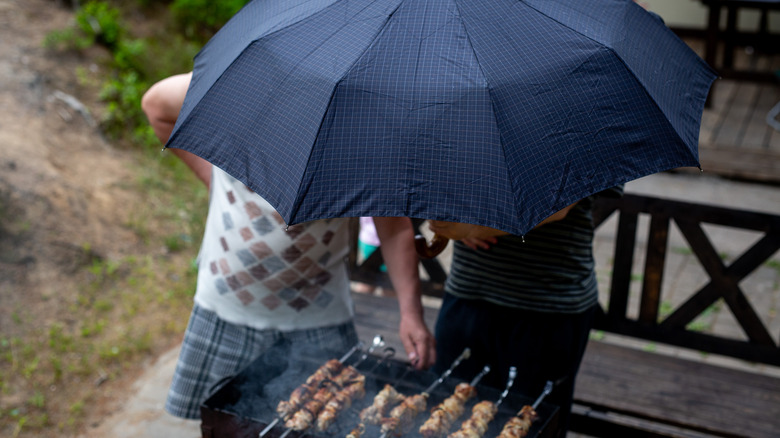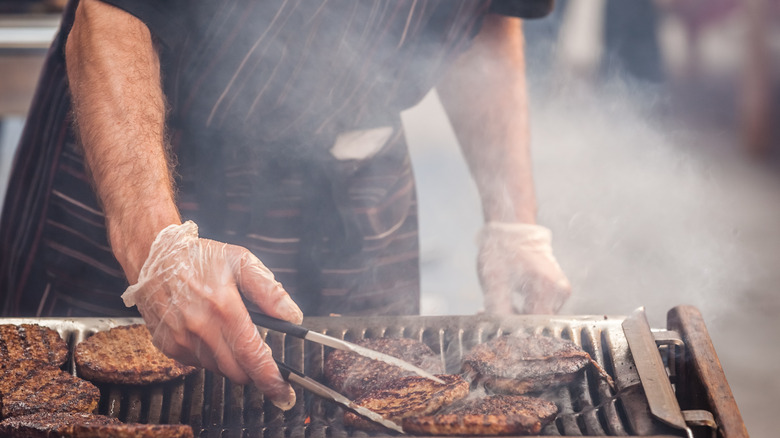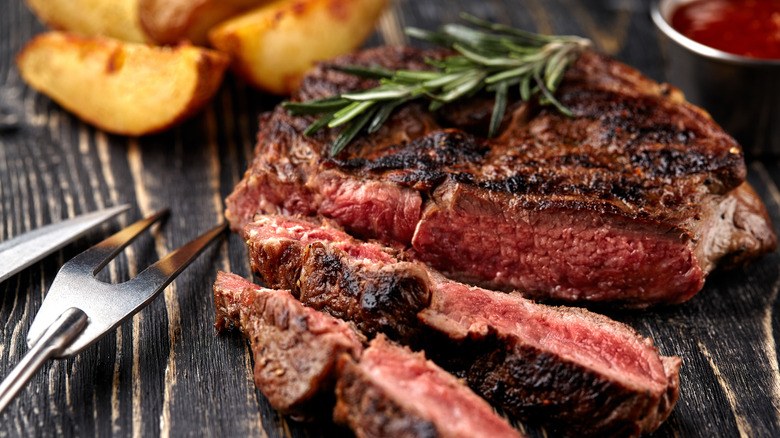There’s nothing quite like a burger or steak off the grill on a hot summer day, isn’t there? Grilling feels like the most primal of cooking techniques, adding a certain caveman sort of flair to the proceedings. It’s also beloved by many quite simply because it’s pretty hard to mess up. Or, at least, grilling seems to be pretty easy the way it looks to so many of us. All you have to do just light a fire, toss on some steaks, and you’re done. Right?
Actually, not so much. Grilling can be plenty fun and simple, to be sure, but it’s not free of pitfalls. As with all other cooking techniques, there’s a fair amount that can go wrong along the way, at least if you’re uninformed or don’t give the grill a bit more of your attention. All of that grilling comes along with plenty of misleading myths that people continue to believe are impacting their grillmaster status. Yet, those tales aren’t quite right.
From whether or not we should be cutting into or poking meat, to the importance of flipping, to just how hot that grill is supposed to be, there are absolutely some misleading myths out there! Get things straight, though, and there just may be a beautiful steak in your future. Here are nine grilling myths you can stop believing.
Cut into meat mid-grilling to check doneness

It’s commonly believed it’s a good practice to cut into any meat to tell how cooked it is. But that is actually just a myth and, frankly speaking, it’s just not a good idea. “Cutting into meat creates moisture loss, and taking an estimate by using your eyes could lead to eating undercooked meat and spreading foodborne illness,” Jessica Randhawa, the head chef and recipe creator behind The Forked Spoon, told Look. In other words, you can’t always trust your own eyes. Instead you should look for help from a small technological wonder: the thermometer.
Not using a digital thermometer is easily the most common mistake most people make when grilling meat in general. Not using one can put you into murky waters, at least in terms of food safety. The USDA recommends checking to make sure that the internal temperature of a cut of meat is right using a thermometer.
Randhawa agrees that these things are vital. “I always have a digital thermometer handy for all my cooking, especially meats, to ensure that the internal temperature is perfect for the recipe I am making,” she said. Generally, a decent digital thermometer is pretty easy to acquire and use, especially considering how much help it will be beyond the grill. Most digital thermometers are very affordable and often even have cooking temperatures printed on them, including steak’s various doneness levels, all so you can make sure your meat is perfectly and safely done.
You can’t grill in cold or rainy weather

While it’s true that summer is the main grilling season and the subject of many an idyllic scene, you can actually grill any time of the year and in practically any weather. “I have lived most of my life in Finland where it gets really cold in the winter and sometimes I have grilled food even in freezing cold temperatures,” Joonas Jokiniemi, founder of Grill Smoke Love, told Look. That doesn’t mean it’s all exactly the same. “Of course, it’s not very pleasant and requires a proper shelter and a grill that can produce enough heat!” he said.
Ready to get grilling during the supposed offseason? First, you need to have a grilling area that is protected from the elements. You also need to consider the exact type of grill you’re using. “Some gas grills might not get hot enough for grilling in cold weather but most of them will,” said Jokiniemi.
Oftentimes, if you’re grilling in cold or rainy weather, you will need to preheat the grill a bit longer with the lid closed. “If you use a charcoal grill, simply add more charcoal than usual and you can easily reach searing hot temperatures,” said Jokiniemi. “And one great way to grill in the wintertime is to put a metal grid in your fireplace and do it indoors.” So long as you have a carbon monoxide alarm nearby, just in case, who’s to say you can’t give it a try?
Searing locks in flavor

Shutterstock
“One of the main grilling myths that I frequently encounter is the idea that when you sear something, you are searing in and locking in the juices,” Maille mustard sommelier Brandon Collins told Look. Unfortunately, that is not the case. When you sear something, what you’re really doing is creating flavor through a process known as the Maillard reaction. Handy as it is, though, this reaction has nothing to do with juiciness. “After you’ve seared and cooked your meat, you still need to let it rest in order to let those juices redistribute throughout the meat,” said Collins.
Simply put, searing does not lock in the flavor. “This won’t work as searing has an entirely different meaning,” Emily Perez, a chef in the New York tri-state area, told Look.
In the culinary world, searing means quickly browning your meat over high heat. “Imagine making chicken tikka on the grill, those are also made on high heat but that heat is only used for cooking the meat properly,” said Perez. The flavor is added previously so keep this in mind the next time grilling season is upon us.
What you can do instead is to use searing as a technique to make it look more presentable and aesthetically pleasing. “Searing does make it crunchy and delicious to eat so apply it whenever you grill your meaty meats,” said Perez.
You can’t flip your meat

Shutterstock
It’s commonly said that it’s best not to flip your burgers more than once, lest you lose all the juiciness contained in the meat. This is patently untrue. “Flipping your burgers regularly allows for a more evenly heat distributed burger,” Shawn Hill, grillmaster with TheGrillingDad, told Look. That means each bite will be exactly the same, which is clearly what you want in a perfectly cooked burger. As it turns out, flipping the meat on the grill can be key to thoroughly cooking everything and making sure it all has great flavor.
That said, it’s a good idea to wait a bit before the first flip. According to Country Living, it’s best to let that burger patty cook for at least three to four minutes before trying that first maneuver. That will give the meat time to get a good sear. Otherwise, it may not hold its form and can just fall apart, especially when we’re talking about ground meat creations like burgers. No one wants that, right? After that first move, you can flip as often as you want.
So, flip away. Whether that means just once or every other minute is up to you. It’s your burger, after all! Just remember not to overcrowd the grill and avoid some other grill-related mistakes.
You can set up the grill and walk away

Shutterstock
While there are plenty of set-it-and-forget-it kind of recipes out there, grilling just isn’t the time to let your attention wander. Pay close attention to the grill while cooking. Todd Harrington, Director of Culinary Operations at Blau + Associates, told Look that, “For many people, grilling is an event that doesn’t happen very often. So, for me, I feel that paying close attention to the grill throughout the cooking process yields the best results. Unless I am smoking something for a long period of time, you will always find me standing at the grill (without budging). This is to ensure the food that I am grilling is being cared for as it specifically needs.”
Sure, it may seem like a lot of work, but remember that a little care and consideration can make for great grilled food later.
As Todd states, “A few things to always prioritize when grilling are ‘attention,’ ‘timing,’ and ‘resting.’ Pay attention to each item specifically. Timing is important, as cooking for a group of friends and family can get overwhelming if you’re not able to get the food ready within a reasonable timeframe.” Don’t forget about the crucial resting step, either. “The resting period is also a part of the cooking process that many overlook. It is crucial to rest any meat after it comes off the grill to ensure it doesn’t dry out and stays juicy and flavorful for your guests!”
Your whole grill has to be hot

Shutterstock
Another common grilling myth is the belief that the whole grill should be hot across the entirety of the grate. Now, obviously, you want a hot grill to some extent, or else you wouldn’t be able to cook your meat in the first place. However, heat needs a little more careful consideration. Having sections of your grill with varying heat levels can be a big asset and will mark you out as a true master of the summer cookout!
“When using a grill, you should have two zones,” chef Brandon Collins told Look. “One that is hot and heated by the coals or burners, and one that is not as hot and is heated indirectly from the other side.” That’s all you need to have some flexibility in your cooking that will pay out dividends in beautifully prepared meat and other grilled foods.
According to Collins, having these two “hot zones” is important because it gives you greater temperature control while cooking. “If one side is too hot,” he says, “you can move your meat or vegetables around in order to find the right temperature that will allow you can cook your food evenly without burning the outside and keeping the inside raw,” said Collins. Once again, you’ll need to stay at your grill to ensure that this technique works as you carefully consider where each cuts need to land for cooking perfection.
You can tell the temperature of your grill by holding your hand over it

Shutterstock
We often like to give ourselves a little too much credit for our senses in the kitchen, especially when it comes to temperature. But, let’s face it: we’re just not as accurate as a thermometer. This means that the old trick of holding your hand over the grill to check its temperature is just not a great way to get an accurate read of the temp.
For instance, consider that each one of us has a different “pain” tolerance or, more gently, a different understanding of how “hot” feels. “For instance, I, as a chef, may be able to keep my hand over a hot grill for a much longer period of time due to the fact that my body has become accustomed to the heat over the years,” says Collins. “[This] will result in a different reading compared to someone who is less accustomed to high heat.”
The physical distance from where you take the temperate matters as well. “if I am holding my hand one foot from the grate or one inch from the grate, there is going to be a serious temperature difference,” said Collins. For a better test of temperature, Collins will usually splash a bit of water on the grate. If it instantly evaporates, that’s a good sign that it’s ready to go. Of course, you can always use a handy thermometer for the most accurate reading.
Marinades penetrate deep into meat and tenderize it

Shutterstock
Marinades are a tricky thing to understand, especially if you’re convinced that they’re really getting deep into a cut of meat. While there’s some level of truth to this myth, it’s ultimately pretty misleading. The marinade truth really depends on the size of the meat you are marinating, as well as the amount of time the meat sits in the marinade.
“A smaller, thin piece of meat such as a skirt steak will benefit much more from a marinade than something larger, like a pork shoulder,” chef Brandon Collins told Look. While the salt tends to penetrate fairly well into the meat, other flavors in the marinade are much harder to enmesh much beyond the surface level.
“With a skirt steak, the one-eighth to one-quarter inch of marinade penetration is basically the whole piece of meat,” said Collins, “whereas with a pork shoulder, you have barely scratched the surface. If you’re looking to get the most out of your marinades, you can cut larger pieces of meat down to smaller sizes, or slice holes into the meat to allow a greater surface area of the marinade to penetrate.” And don’t give up on marinades completely, either, as they can still add an interesting flavor to the final piece. Just remember that the idea of endlessly soaking a cut of meat in marinade for hours beforehand is also a myth that you can conveniently toss before your next grilling adventure.
The pink juice from a steak is blood

Shutterstock
When slicing into a steak, you might see some pink fluids pour out. Is that blood? Is your meat still raw? Should you freak out? No need to rethink your cooking technique here, however. That’s not blood and you should be completely safe to chow down on the finished meat.
The pink and red juice you see running from a steak is not blood but a mixture of water and myoglobin, the substance that delivers the oxygen to the muscles. “As we cook the steak, the myoglobin darkens (this is what leads to what we see as a well-done steak),” Collins told Look. “This misconception about blood is also why some meatpackers package their meat with “gas”, to keep the color brighter for longer as we associate the color of the steak with freshness and quality.”
No matter how many times this misconception is cleared up, people tend to just see red and automatically assume that it must be blood, regardless of the science behind it. “At the end of the day, considering that blood does not contain myoglobin, it would be quite impossible for those red juices to be blood,” said Collins. So, even if you’ve completely dismissed the idea of blood as an ingredient — though, if you do, you’d be missing out on some classic British food — just remember that the pink stuff coming from your steak isn’t blood and is totally natural.







